Ron Judkoff Receives ASHRAE Distinguished Service Award for 41 Years of Pioneering Buildings Research
Inside the Career of NREL's Chief Architectural Engineer
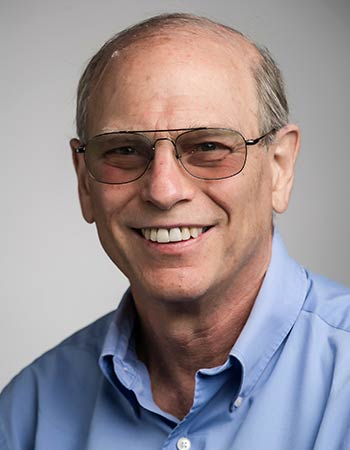
Ron Judkoff, chief architectural engineer for the U.S. Department of Energy's (DOE) National Renewable Energy Laboratory (NREL), has received the ASHRAE Distinguished Service Award at the society's June 2019 annual conference in Kansas City, Mo. The award recognizes Judkoff's technical contributions to ASHRAE, including work with the International Energy Agency leading the development of ANSI/ASHRAE Standard 140, the international standard of accuracy for large-building energy simulations. Judkoff's contributions reflect a career spanning four decades of innovation in building science research at NREL.
"Ron was one of the early leaders around building energy modeling," says longtime colleague and Commercial Buildings Research Group Principal Engineer Paul Torcellini. "Especially early on when I knew him, he spent a lot of time performing diagnostics on modeling. If a model doesn't predict the performance of a building, it's no good."
Torcellini notes that despite a general notion that buildings are relatively simple systems, the science predicting building energy performance is very complex. Judkoff spent years focused on model comparisons to determine which models better predict reality, including comparisons with experimental data from manufactured homes he wheeled into a climate-controlled warehouse located near NREL in Golden, Colo.
Torcellini continues, "There are lots of building models out there. [Judkoff's] idea was that if you use a lot of different models, they should be saying the same thing. That later became the ASHRAE standard."
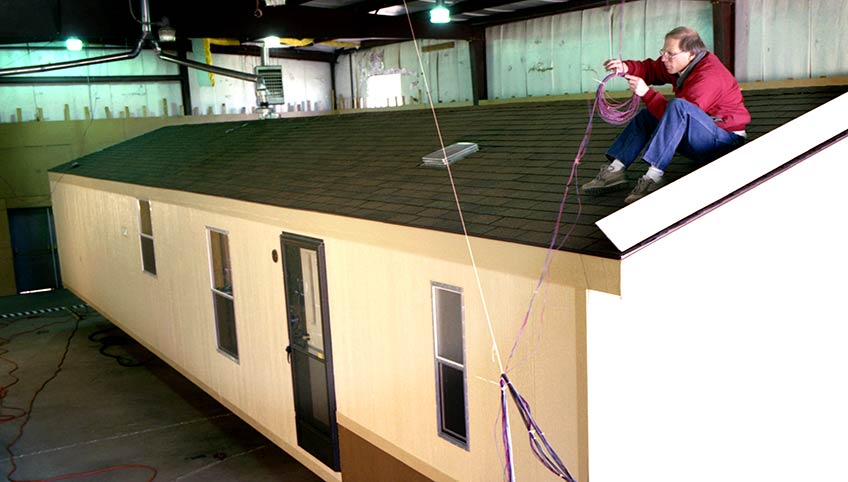
Judkoff found ways to measure the efficiency of mobile homes for the Federal Low-Income Weatherization Program, establishing new U.S. Department of Housing and Urban Development standards as part of the process. Photo by Warren Gretz, NREL
Colleagues praise Judkoff's sustained focus on validation of building energy performance models. 2018‒2019 ASHRAE President Sheila Hayter has worked with Judkoff at NREL since 1992. Of his contributions to ASHRAE, she says, "Ron and [former NREL colleague and continued collaborator] Joel Neymark have been so involved and integrated in working on Standard 140 activities for the last 25 years. … Anyone who can stick with a project for so many years—that's a labor of love."
Starting Out in the Early Days of Renewables Research
For Judkoff, the inspiration to make America's buildings more efficient came from West Africa. During a three-year Peace Corps stint there in the 1970s, he helped construct birthing clinics, dig water wells, and build sanitary facilities. "I learned that I really liked building, and thinking about the technical aspects of building. I was especially fascinated by the thermal performance of indigenous architecture without heating or cooling systems." Low-tech sometimes proved to be the optimal choice: while a modern building in Dakar would become uninhabitable during frequent power failures, Judkoff's mud hut in Burkina Faso was comfortable with no energy source at all.
When he returned to the United States—after hitchhiking through the Sahara Desert—he set out to get a master's degree in architecture at Columbia University. Against the backdrop of the 1978 oil crisis, he had found his lifelong path.
"It's the most satisfying thing in the world—to have been able to spend my whole career working with great people, where you can look at yourself in the mirror and say, ‘I'm working on something really good.'"
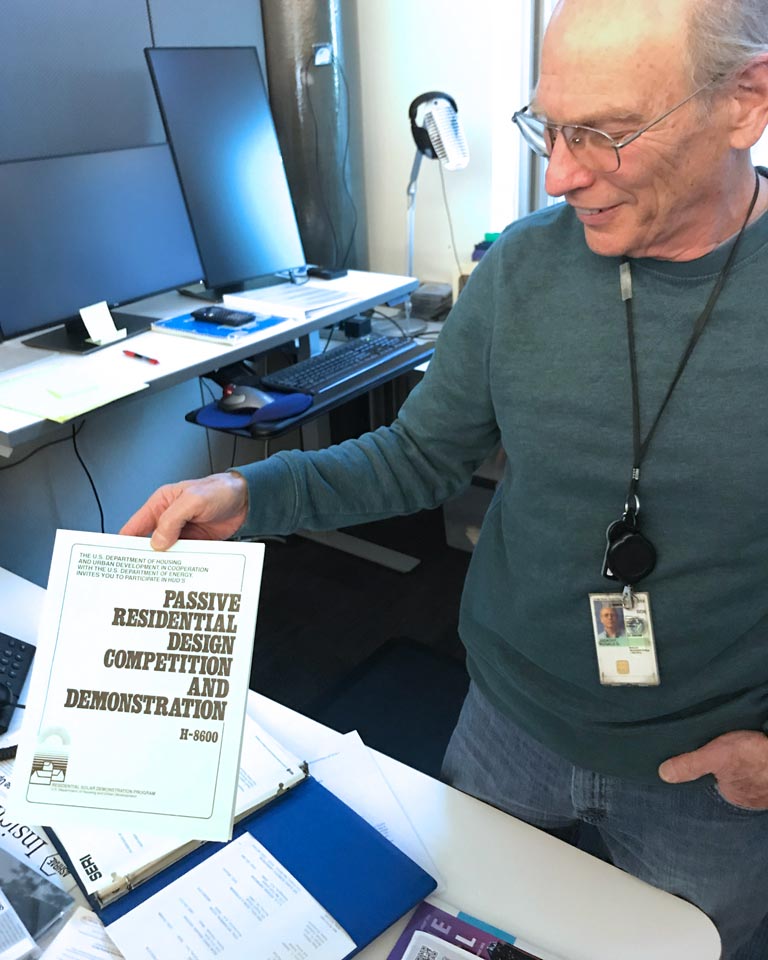
Judkoff's tendency to seek new ways of doing things fueled his studies in graduate school, and he left Columbia ready to help effect change in America's built environment. Seeking employment, he saw a newspaper advertisement that Brookhaven National Laboratory (BNL) was starting up a building efficiency program that included solar power. "All I knew about national labs was: ‘They put men on the moon, don't they?'" he says. "Sounded like a pretty cool place to work."
At BNL, Judkoff gained exposure to building efficiency technologies such as solar hot water. His time at BNL helped him understand "the potential for computer modeling…Questions you couldn't otherwise answer by doing hand calculations could be answered with modeling, but we needed to make the models practical for architects and engineers to use."
After BNL, Judkoff joined the buildings team as its first member at the new Solar Energy Research Institute (SERI), the laboratory that would later become NREL. "It seemed like a wonderful opportunity, and living in Colorado was a bonus," he says.
Creating a Track Record in Buildings
When Judkoff began working at SERI, the buildings group was considered part of the "passive" solar program. The so-called "active" solar work involved solar thermal technologies, photovoltaics (PV), and concentrating solar power.
Despite passive technologies sounding, well, passive, Judkoff and his colleagues were dreaming big—envisioning a time of zero energy buildings, PV paint, and three-dimensional software to optimize ultra-efficient buildings quickly and economically. It wasn't PV pie in the sky, though. "That's why we were [at NREL]. It wasn't that I was so prescient. Why set up this place unless that was the dream?"
As it turned out, he has lived that vision. "It's the most satisfying thing in the world—to have been able to spend my whole career working with great people, where you can look at yourself in the mirror and say, ‘I'm working on something really good.'"
Judkoff's first real project began in May 1978, helping launch the U.S. Department of Housing and Urban Development's Passive Solar Competition, a collaboration with DOE aimed at architects who would submit plans. "Then, if some of those houses were built, we would monitor them and see how well they did," he says.
Judkoff developed technical specifications for the competition. "There were no computers, and we mimeographed stuff," he chuckles. It was a hit with some 250 homes built. The competition included two levels of monitoring, helping provide data for home efficiency and putting passive solar home design into practice.
In the early 1990s, Judkoff began evaluating mobile homes as part of a federal low-income weatherization program. Overall, the program had been successful in delivering energy savings through retrofits of site-built homes, but program leaders weren't seeing efficiency returns on mobile homes. "They were going to cut mobile homes from the program, but wanted another set of eyes," Judkoff says.
Partnering with the Colorado state weatherization program, Judkoff endeavored to identify the most efficient ways to retrofit mobile homes. He developed the notion of testing homes via calorimetry in a controlled environment. In this case, the controlled environment was a rented church gym, 100-by-50-by-30 feet in size, upgraded with a larger overhead door. The church gym became the program testbed for about three years. There, Judkoff organized workshops, bringing hands-on experts from around the country to test methods to retrofit mobile homes for better efficiency.
His approach worked. In the end, the weatherization program kept mobile homes as a category, and Lawrence Berkeley National Laboratory found that these retrofits were among the most energy efficient and cost-effective in the program. The project, his favorite, won him a Federal Laboratory Consortium Award and provided a repository of information. "I gave a voice and scientific credibility to the ideas of hands-on weatherization professionals from throughout the country," he says.
Praising his work developing building performance standards for manufactured homes, Hayter says, "His work did a lot to help improve the built environment for people who were very challenged in being able to afford their energy bills."
The calorimetry approach and facility that Judkoff developed were adopted by NREL transportation researchers, who later took over the space to test the efficiency of long-haul truck cabs. Experience gained through Judkoff's work with manufactured modular buildings also informed a new NREL Buildings Center project, Integrating Energy Efficiency and Distributed Energy Resources into Advanced Manufacturing of Buildings.
A Place at the Drawing Table
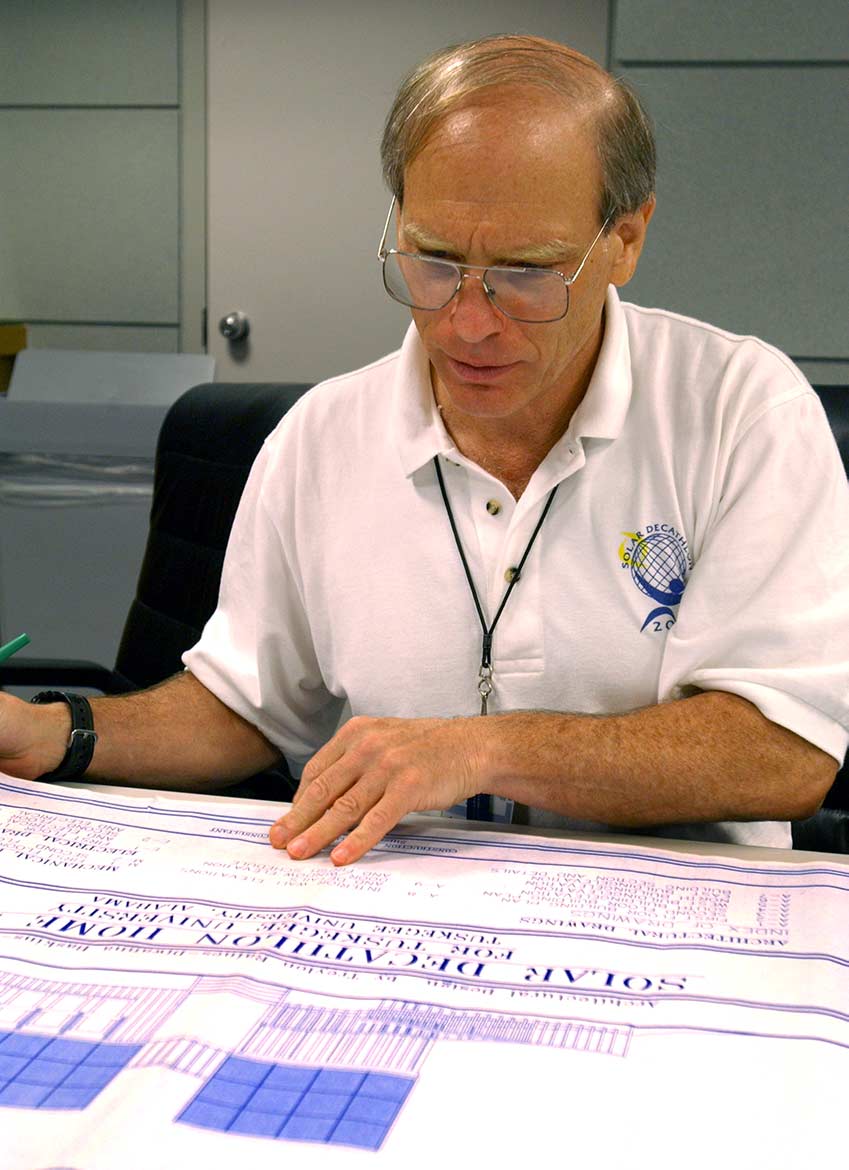
Judkoff's presence at NREL from its beginnings has given him the opportunity to shape the laboratory's development. As the NREL campus expanded, he collaborated closely with the architects and engineers who were designing the Solar Energy Research Facility. "That started the tradition of experts from the NREL buildings research group being involved in all the subsequent campus building projects," Judkoff says.
After the Solar Energy Research Facility was built, a similar design-build process was used for the Thermal Test Facility, the Science and Technology Facility, the Research Support Facility, and the Energy Systems Integration Facility. These exemplary buildings not only "walked the talk," but also gave NREL a reputation for being the best source of knowledge on how to design ultra-efficient zero energy buildings. Judkoff and his team won multiple national awards for these buildings, including a first-place ASHRAE Technology Award, a Federal Energy and Water Management Award, and a Federal Energy Saver Showcase Award.
Judkoff retains an encyclopedic knowledge of NREL building design. "When I see the evolution of the buildings on campus, they've gotten better and better because we learned from each building," he says. He cites complex lighting controls in the Science and Technology Facility as one prime example. As a result, "When we did the Research Support Facility, we did the lighting controls really simply—and it has worked. We carried that knowledge into the Energy Systems Integration Facility."
These innovations reach beyond NREL's campus, in Judkoff's opinion. "Because we did zero energy buildings and won prestigious engineering and architecture awards along the way, a lot of other architects and engineers are taking the time to learn how to do it," he explains. "The state of California is now requiring zero energy buildings in their upcoming [building] code. And other states are starting to follow suit." Judkoff's zero energy buildings research also informed his work as an energy consultant on behalf of NREL for the design of the Zion National Park Visitor Center, winner of an American Institute of Architects Committee on the Environment Top Ten Sustainable Building award in 2001. These and other demonstrated successes prompted DOE to assign NREL a leadership role in developing the Advanced Energy Design Guides, influential publications produced by ASHRAE, American Institute of Architects, Illuminating Engineering Society of North America, U.S. Green Building Council, and DOE. The guides offer practical, sector-specific approaches to achieving building energy savings beyond code requirements up to and including zero energy.
Fostering the Next Generation of Research
Looking back on his career, Judkoff notes "threads of evolution," wherein his research and demonstration projects received early recognition that led to expanded investment by DOE and eventually the market.
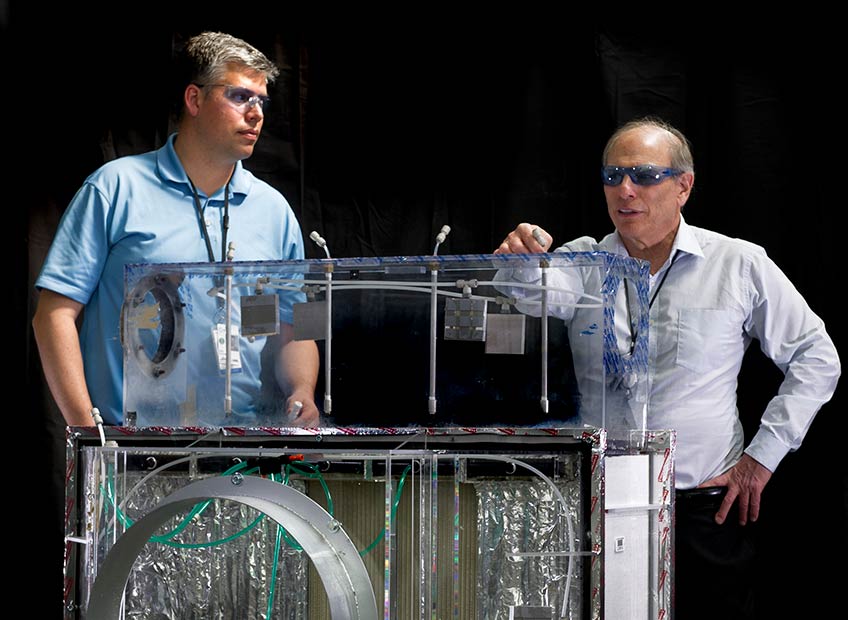
Judkoff shared an R&D 100 Award in 2012 with Eric Kozubal (left) and others for DEVap: desiccant-enhanced evaporative air conditioning. Photo by Dennis Schroeder, NREL
For instance, Judkoff led the development of NREL's SUNREL Energy Analysis Software, which shared a 2005 R&D 100 Award with project sponsor New York State Energy Research and Development Authority. SUNREL was adopted as the physics and mathematics engine behind New York State's Targeted Retrofit Energy Analysis Tool, a building energy audit software tool that enables auditors to perform more accurate building assessments and prioritize energy-efficiency upgrade projects. The tool was used to serve residential and multifamily customers throughout the state and was eventually licensed by energy-efficiency programs from other states. Judkoff credits the successes of SUNREL in part for expanded investment in energy simulation research. NREL now has an entire team supporting DOE's EnergyPlus software, a whole-building energy simulation program that engineers, architects, and researchers use to model both energy consumption and water use in buildings. "I am in awe of what the many colleagues who have followed me into building energy research at NREL have accomplished. EnergyPlus and offshoots such as URBANopt and ResStock are approaching and exceeding our original vision for building energy software more than 40 years ago. We now have the capability to model the built environment regionally and perform modeling sweeps of the entire country," he says.
Judkoff predicts input calibration for building energy simulation software will become another "thread" wherein early recognition evolves to expanded investment in research and growth at NREL. Many calibration techniques exist, but there was no method for testing their accuracy until Judkoff partnered with the Residential Energy Services Network (RESNET) to develop an American National Standards Institute (ANSI)/RESNET Standard Method of Test for this purpose. "This standard is a little ahead of its time," says Judkoff, but he predicts that it will gain recognition as the architecture and engineering industry demands higher-fidelity energy modeling and computer power expands to accommodate large-scale automated calibration techniques. "We'll just have to wait and see what happens."
NREL colleagues attest to Judkoff's influence. "Ron was my center director 20 years ago when I first started at NREL," Senior Commercial Buildings Research Engineer Shanti Pless says. "I had the chance to work side by side with Ron over the past two years in setting up our apartment-in-the-loop research platform in the Energy Systems Integration Facility, and his continued passion and depth of experience for building science and efficiency is impressive. I always find it useful to be able to work with someone who has a career's worth of experience to guide our research."
Last Updated May 28, 2025
